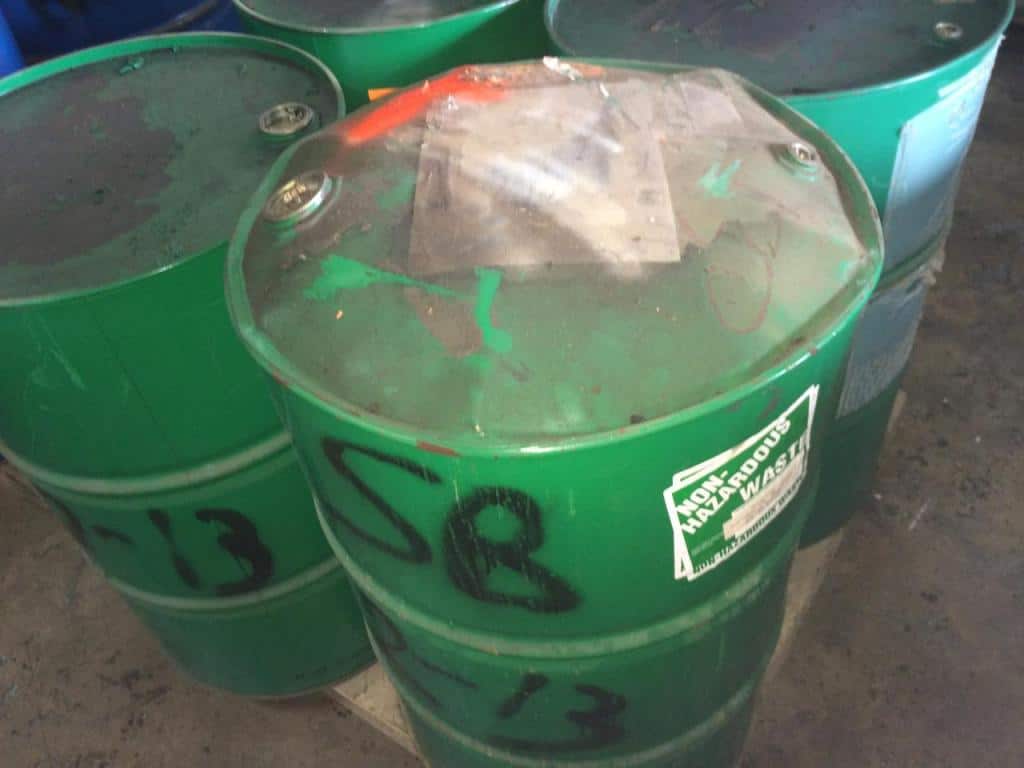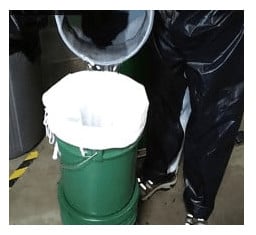[print-me printstyle=”pom-small-grey”]
Responsibility Of Paint Waste Removal Is On You!
 Recently, in North Carolina a commercial property owner requested that an auto body shop pay for hazardous waste cleanup. This is an ever-increasing example of waste issues experienced by auto body shops across the country. Environmental waste producers such as an auto body shop are being held responsible for their materials regardless of good faith practices in contracting others to dispose of the waste. Shops carry a responsibility of cleanup costs regardless of violations occurring downstream in the waste disposal process.
Recently, in North Carolina a commercial property owner requested that an auto body shop pay for hazardous waste cleanup. This is an ever-increasing example of waste issues experienced by auto body shops across the country. Environmental waste producers such as an auto body shop are being held responsible for their materials regardless of good faith practices in contracting others to dispose of the waste. Shops carry a responsibility of cleanup costs regardless of violations occurring downstream in the waste disposal process.
Recent North Carolina Case
In 2017 a North Carolina commercial Property owners counsel contacted A-1 Auto Body with a “carrot and stick” offer. “Pay $2,000 in a one-time settlement and indemnification or risk a lawsuit.” This was to recoup what the shop owed for cleaning up a former site. This was related to 165 gallons of the shop’s hazardous waste.
A-1 Auto Body had contracted with an environmental group to remove the waste generated by their body shop. Materials were sent to a facility which contained residual contaminants from years of treating solvents leading regulators to take action.
Regulators desired to recover the costs under the Comprehensive Environmental Response, Compensation, and Liability Act. This is for parties who generated and transported waste to the facility. Regulators further said that CERCLA, “has nothing to do with fault.”
The EPA spokesperson in December 2017 indicated that a hazardous waste producer can be held responsible “for the presence of hazardous substances at a site,” under CERCLA. This responsibility was passed on even if the producer didn’t put the waste there.
Superfund Law
 “For example, the Superfund law (officially the Comprehensive Environmental Response, Compensation and Liability Act) imposes liability on parties responsible for, in whole or in part, the presence of hazardous substances at a site,” the spokesperson wrote.
“For example, the Superfund law (officially the Comprehensive Environmental Response, Compensation and Liability Act) imposes liability on parties responsible for, in whole or in part, the presence of hazardous substances at a site,” the spokesperson wrote.
Superfund liability when:
- Hazardous wastes are present at a facility
- If there is a release (or a possibility of a release) of these hazardous substances,
- When response costs have been or will be incurred
- The defendant is a liable party.
There are four classes of Superfund liable parties:
- If current owners and operators of a facility
- The past owners and operators of a facility at the time hazardous wastes were disposed
- That they are the generators and parties that arranged for the disposal or transport of the hazardous substances
- As well as, transporters of hazardous waste that selected the site where the hazardous substances were brought.
“Of course, even if a party takes a cleanup action under an authority other than CERCLA (e.g. RCRA corrective action), it may have a right of cost recovery under CERCLA section 107. If the action was a necessary response to a release of hazardous substances and was performed consistent with the NCP.”
Clean Up Recovery Could Cost You Thousands
 Waste paint in shops generates a large waste stream resulting in a costly removal for paint shops. Storage of waste paint is also a common area for EPA fines, as storing waste paint is highly regulated. Accruing waste paint in improper environments is a violation of code according to OSHA and EPA standards. Improperly stored waste paint will result in fines that could amount to thousands possibly even hundreds of thousands of dollars. This is according to the Federal Register, the U.S. Federal Government’s regulation of federal agencies, 40 CFR 265.173(a) and (b). Therefore it is important to ensure that any shop using paint is properly disposing of the waste.
Waste paint in shops generates a large waste stream resulting in a costly removal for paint shops. Storage of waste paint is also a common area for EPA fines, as storing waste paint is highly regulated. Accruing waste paint in improper environments is a violation of code according to OSHA and EPA standards. Improperly stored waste paint will result in fines that could amount to thousands possibly even hundreds of thousands of dollars. This is according to the Federal Register, the U.S. Federal Government’s regulation of federal agencies, 40 CFR 265.173(a) and (b). Therefore it is important to ensure that any shop using paint is properly disposing of the waste.
Solutions To Paint & Solvent Waste
Options For Hazardous Waste Paint Removal
Hazardous Waste Removal Services will retrieve hazardous waste and deal with the waste in their own methods. All the while you maintain the responsibility for the waste and its proper disposal despite a Hazardous Waste Disposal Company taking possession.
Recycling Solvent Waste
Recycling is a form of extracting paint waste and reusing the recovered liquid. There are multiple methods of recycling including distillation with vacuum assist, filtration, and flocculation with filtration.

-
Distillation with vacuum assist:
Distillation with vacuum assist uses a solvent distillation unit (recycler) to extract the remaining water from waterborne waste paint. This process is successful in removing 100% of the paint waste from the liquid. Though, this solution for waterborne waste paint is not an economical solution. Time and money are large issues that arise when using a recycler for waterborne waste paint. The time it takes to extract the water from waste paint is a long process in comparison to other options available, taking as long as a day to complete the distillation process.
The other issue is money, recyclers cost anywhere from $3,000 to $50,000. Another recommendation to successfully distill waterborne waste paint is a vacuum assist, which allows for effective and timely processing of the solvent distillation unit. That said, money that a recycling unit saves in waste costs doesn’t compensate for the money that was spent on the unit in waterborne recycling. As a result, the return on investment is almost non-existent. Additionally, there are much more cost-effective methods for recycling waterborne waste paint.

-
Filtration Recycling
Filtration is another method of recycling waterborne waste paint. The process of Filtration Recycling consists of micron filter tubes that filter out the paint in either solvent or waterborne gun cleaners. This process is effective for use in shops that have primarily converted to waterborne paint and distilling solvents is no longer cost-effective. Filtration is a successful method of reusing liquids, although it might leave a slight coloration in the liquid being filtered. This occurs because the filters only filter out to 25 microns, therefore it is leaving a small percentage of paint, filtering out approximately 90-95% of the used paint.
Adding filtration to a gun cleaner can cost anywhere from $700 to $1,500 and filter replacement can cost anywhere from $50 to $150 dollars depending on what filter system you are using. The amount of use and care depends on how much a shop will need to replace filters. When filters cared for properly they last anywhere from 1 to 3 months.
-
Flocculation with filtration recycling:
Flocculation with Filtration is a process where an absorbent
 is poured into the waterborne waste created by gun cleaners and the absorbent causes the paint material to clump together. Once stirred and settled the water is poured through micron filter bags and the paint material is separated from the water. The water is then good to use again and the remaining waste paint is ready for disposal processes. Flocculation materials cost between $60 to $230 per container and recommended that the flocculation process occur at least once a week.
is poured into the waterborne waste created by gun cleaners and the absorbent causes the paint material to clump together. Once stirred and settled the water is poured through micron filter bags and the paint material is separated from the water. The water is then good to use again and the remaining waste paint is ready for disposal processes. Flocculation materials cost between $60 to $230 per container and recommended that the flocculation process occur at least once a week. -
Dried to waste recycling:
Dried To Waste are compounds when added to hazardous waste paint solidifies the material and is acceptable for disposal.

Absorbents are compounds that are added to waste paint resulting in a dried and hardened waste.
- Are able to make hazardous materials dry and nonflammable allowing for it to be disposed of as regular waste.
- Cost effective for paint shops and supply a quick and easy process for the disposal of hazardous waste (waste paint).
- May be purchased ranging from $50 to $300 depending on the size of the container. The lifespan of the absorbents depends on the amount of waste paint being generated.
To ensure requirements are met hazardous waste tests are conducted. This test evaluates TCLP (test for heavy metals), dryness, and flammability. This happens once recycling processes have occurred or absorbents have been added to waste paint solutions and the hardening process is complete.
Recycling Methods
 Recycling methods include filtration, flocculation with filtration, and absorbents are all excellent solutions for filtering and reusing or disposal of waterborne waste paint. Each provides cost-effective answers to expensive processes which occur in everyday functions of any shop using waterborne paints. The compliance of these products with OSHA, EPA, and Federal regulations providing environmental solutions and give shops a solution to legal issues concerning paint waste. With the use of recycling methods or absorbents mentioned any shop can avoid expensive costs of hazardous waste removal services and distillation units for waterborne paint waste.
Recycling methods include filtration, flocculation with filtration, and absorbents are all excellent solutions for filtering and reusing or disposal of waterborne waste paint. Each provides cost-effective answers to expensive processes which occur in everyday functions of any shop using waterborne paints. The compliance of these products with OSHA, EPA, and Federal regulations providing environmental solutions and give shops a solution to legal issues concerning paint waste. With the use of recycling methods or absorbents mentioned any shop can avoid expensive costs of hazardous waste removal services and distillation units for waterborne paint waste.
*Disclaimer: Please review your state jurisdictions guidelines and procedures to assure that your process is compliant.
Further Reading>>>
Hazardous Waste Violations: EPA Fines Have Increased
Waste Paint Can Costs Shops Big Money

